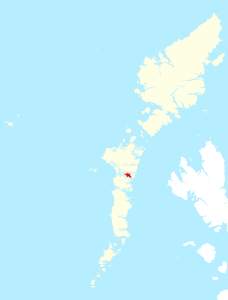Grimsay
| Grimsay | |
|---|---|
| Bàgh Mòr / Baymore on Grimsay | |
| Waters | North Atlantic |
| Archipelago | Outer Hebrides |
| Geographical location | 57 ° 29 '24 " N , 7 ° 14' 24" W |
| surface | 8.33 km² |
| Highest elevation | 22 m |
| Residents | 169 (2011) 20 inhabitants / km² |
| main place | Bàgh Mòr and Ceallan |
Grimsay ( Scottish Gaelic : Griomasaigh ) is an island in the Outer Hebrides of Scotland , connected by dams to North Uist and Benbecula . In 2011, 169 people lived on Grimsay.
etymology
The name means Grims Island. Grim goes back to the Anglo-Saxons or Normans . He is a synonym for the Norse god Odin . See also Graemsay Isle of Orkney , Grimsby Place in Lincolnshire , Grimsbury Castle Hillfort in Oxfordshire , Grim's Ditch an earthwork , Grim's Dyke (name for the Antonine Wall ), Grim's Grave stone chest (also kistvaen) in Dartmoor . Grimes Graves flint mines, Grimshader (Grims Seat) on Lewis and Harris, Grims Lake Mire (a stone chest in Grims Lake Morass), Grim's Mound a round hill in Lincolnshire, Grimspound in Devon , Grimsetter (Grims Seat) on Orkney and Shetland, Grimsthorpe Castle ( Grims Village), as well as several places called Grimston ( Grimston-Lyles Hill Ware ).
The largest towns on Grimsay are Baymore (Bàgh Mòr) and Kallin (Ceallan). The main occupation today is fishing for lobsters . Earlier who was shipbuilding important. The island is of particular prehistoric interest due to the particularly well-preserved Wheelhouse Bagh nam Feadag and Dun Ban , an "Atlantic Roundhouse".
Individual evidence
- ↑ 2011 census data
- ↑ Grimsay Wheelhouse . Alasdair McKenzie. Retrieved January 1, 2011.

